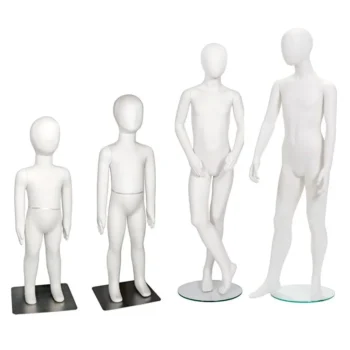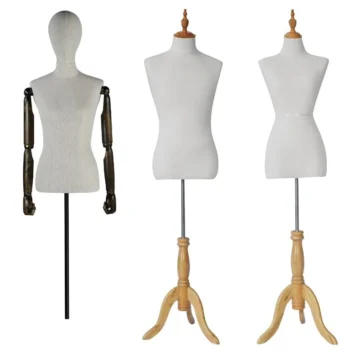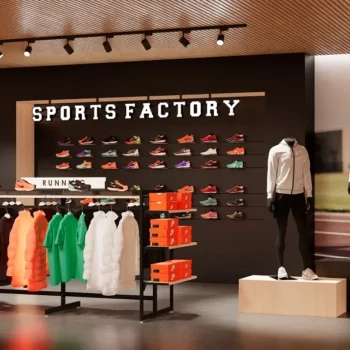Mannequins
Mannequins for Every Retail Need
Mannequins are essential tools in visual merchandising, helping customers envision how garments will look and fit. At Apex Display, we offer a diverse range of mannequins for sale to suit any retail environment. From full-body male mannequins to sleek female mannequin torsos, our selection is crafted to enhance your store’s displays, attract attention, and increase customer engagement.
-
Female Mannequins
Female Mannequins -
Male Mannequins
Male Mannequins -
Child Mannequins
Child Mannequins for Engaging Displays -
Hanging Bodyforms
Hanging Bodyforms for Space-Saving and Dynamic Displays -
Torsos And Bases
Torsos and Bases: Flexible Display Options
Broader Product Range
Our comprehensive range includes:
- Full-Body Mannequins: Available in both male mannequins and female mannequins, these life-sized figures are ideal for showcasing complete outfits, including accessories.
- Torsos and Bases: Perfect for displaying tops, shirts, or lingerie, our torso mannequins are available in hanging, counter, or base-mounted forms.
- Mannequin Heads and Legs: These components allow you to customise displays, highlight accessories, or create dynamic setups.
- Child-Sized Mannequins: Scaled-down versions of adult mannequins, tailored for showcasing children’s apparel.
- Boutique-Specific Designs: Featuring unique finishes like fabric and timber bases to match high-end aesthetics.
Applications and Use Cases
Mannequins serve as a versatile display solution for various retail settings:
- Window Displays: Create eye-catching setups to draw customers into your store.
- Themed Promotions: Highlight seasonal collections, new arrivals, or holiday campaigns.
- Complete Looks: Use mannequins to showcase fully-styled outfits, including shoes and accessories, to inspire customers.
- Upselling Opportunities: Encourage add-on purchases by featuring complementary items together.
Educational Content and Material Details
At Apex Display, we prioritise quality and versatility in every mannequin we offer. Our mannequins are crafted from durable materials to ensure long-term use:
- Fibreglass: Lightweight yet sturdy, perfect for high-traffic areas.
- Plastic: Affordable and durable, suitable for portable displays or outdoor use.
- Fabric and Timber: Adds a touch of sophistication to boutique setups.
- Finishes: Choose from matte, gloss, black and white to match your store’s aesthetic.
We also offer mannequins with adjustable features, such as detachable limbs and rotating heads, for flexibility in styling.
Maintenance and Styling Tips
Keep your mannequins in pristine condition and ensure they always make a great impression:
- Cleaning: Use a damp cloth and mild detergent to remove dirt and smudges. Avoid harsh chemicals that may damage the finish.
- Styling: Pin garments at the back for a tailored look. Rotate outfits regularly to keep displays fresh and aligned with seasonal trends.
- Repair: Inspect mannequins regularly for loose joints or scratches and address issues promptly.
Merchandising Strategy and Practical Advice
Mannequins are more than display tools—they’re key elements in your retail strategy. Follow these tips for impactful merchandising:
- Position Strategically: Place mannequins at store entrances or in high-traffic areas to maximise visibility.
- Create Storytelling Displays: Use mannequins to narrate a style story, pairing garments with accessories to inspire purchases.
- Optimise Layout: Avoid overcrowding; space mannequins to allow customers to view them from all angles.
- Create Levels: Use a mix of full-body mannequins, hanging bodyforms, and counterstand torsos to add height variation and visual interest.
- Seasonal Updates: Keep displays relevant by featuring seasonal or promotional items.
- Lighting: Highlight mannequins with focused lighting to enhance their visual appeal.
Customer Education
Choosing the right mannequin can significantly impact your retail displays. Here’s what to consider:
- Target Audience: Select mannequins that reflect your customer demographic, whether petite, plus-size, or child-sized.
- Store Aesthetic: Match mannequins’ finishes and designs with your store’s overall branding.
- Durability: Opt for materials that suit your display environment, such as outdoor-friendly plastic or elegant fibreglass for boutique settings.
Sustainability
We are committed to offering eco-friendly options in our mannequin range. Our sustainable choices include mannequins made from fabric and timber that minimise environmental impact. By choosing these options, you can align your store with modern sustainability values while creating visually stunning displays.











